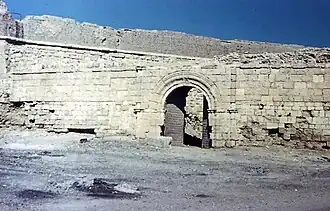El Qoseir Fort
| El Qoseir Fort | |
|---|---|
 | |
| General information | |
| Town or city | El Qoseir |
| Country | Egypt |
| Coordinates | 26°06′19″N 34°16′59″E / 26.10523°N 34.28305°E |
| Year(s) built | 1570s |
| Dimensions | |
| Circumference | 365 meters[a] |
The El Qoseir Fort is an Ottoman fort located in El Qoseir, Egypt. The fort was built on the recommendation of Sinan Pasha in the late 16th century, and it saw notable use during the Napoleonic era. It is a museum in the modern period.
Description
Sinan Pasha suggested the construction of a fort at El Qoseir for the purposes of providing security for the local town. However, according to archeologist Charles Le Quesne,[b] Sinan Pasha might have had additional strategic intentions given the Ottoman conflicts in Yemen at the time. The fort would have also provided security for traveling pilgrims.[2]
In the 1770s, about two hundred years after the foundation of the fort, poet Eyles Irwin visited,[3] and he provided the following description:[4]
The fort of Cosire stands upon a rising ground; and is a square building of about four hundred yards in circumference. It was formerly strong enough, to have withstood a regular attack; the walls being of stone, and raised to a considerable height. But at present, it is in a defenceless state; the breaches which time has made in it, being repaired with mud-work, and not more than three dismantled pieces of cannon left to protect it.
— Eyles Irwin, A Series of Adventures in the Course of a Voyage Up the Red-Sea (1780)
In the 1790s, Napoleon's army occupied the fort and resisted a siege by British naval forces. The fort was rebuilt and then abandoned by the French.[5] Later occupants included the Egyptian Army.[6] By World War II, the town began to expand around the fort which had only rested on the edge of the town up until that time.[7] The fort is a museum in the modern period, and it currently houses a replica of a historical dhow provided by a heritage program of the Red Sea Governorate.[8]
Architecture
The fort contains a tower and barracks.[6]
See also
Notes
References
- ^ Brooks, Alasdair; Young, Ruth (2016). "Historical Archaeology and Heritage in the Middle East: A Preliminary Overview". Historical Archaeology. 50 (4): 22–35. doi:10.1007/BF03379198.
- ^ Le Quesne, Charles (2007). Quseir: An Ottoman and Napoleonic fortress on the Red Sea coast of Egypt. Cairo: American University in Cairo Press. pp. 35, 37. ISBN 9789774160097.
- ^ Le Quesne, 2007, p. 39
- ^ Irwin, Eyles (1780). A series of adventures in the course of a voyage up the Red-Sea, on the coasts of Arabia and Egypt. Dublin. p. 121. OCLC 12759900.
- ^ Doug, Stallings, ed. (2011). Fodor's Egypt. Fodor's Travel Publications. p. 379. ISBN 9781400005192.
- ^ a b Richardson, Dan (2011). The Rough Guide to Egypt. Rough Guides Ltd. ISBN 9781405387712.
- ^ Le Quesne, 2007, p. 14
- ^ Agius, Dionisius A. (2019). The Life of the Red Sea Dhow: A Cultural History of Seaborne Exploration in the Islamic World. Bloomsbury Publishing. ISBN 9781786724878.
As part of the Red Sea governorate heritage programme, a reconstruction of this craft was built ... and placed on exhibition in the fort at Quseir.
_(14776271341).jpg)